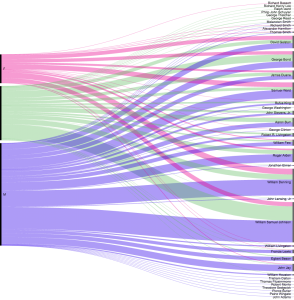A Graph of the Frequency of Authors, Sorted by Gender, in Founding Fathers’ Lending History
To view the data in this graph more closely, click on the image and then zoom in
Upon first glances at the New York Society Library’s Founding Fathers ledgers from 1789-1805, it is evident that the books borrowed from the NYSL during this time were authored by not just men, but women as well. Though some books included in these records lack any author information due to the nature of their content (almanacs, dictionaries, and other reference materials), the majority of the ledger entries incorporate this data. Some author information missing from the ledgers could have been lost over time, forgotten, or accidentally destroyed in the library processes of the past 200 years. Yet, of the authors this ledger does acknowledge, a surprisingly large presence of female authors coexists among more well-known Shakespeare and the Montesquieu texts. These records instill a sense of curiosity regarding these storied men and the minds behind the books they held dear. Viewers of this ledger are left wondering which Founding Fathers appreciated and studied the works of female authors during this formative time in the history of the United States.
This data visualization, created through the online tool RAW Graphs, depicts that 18 of the 38 total Founding Fathers present in the New York Society Library ledgers (or 47%) read works by female writers. The dimensions featured in this graph are author, gender, and borrower name; they are visually linked by flowing colored lines with thicknesses correlating to the amount of books read by that person according to a specific author gender. The gender dimension resides on the left side of the data visualization, and the borrower dimension resides on the right. Pink lines represent female-authored texts, purple lines represent male-authored texts, and green lines represent texts without authors. The more books a certain borrower read, the more room there is under said borrower’s name.
This finding is particularly striking considering the role of women in society during the American Revolution era. Each of the men featured in the data set were included because of their contribution to the American Revolution or the founding of the United States government in the years following; however, many women of their time were uneducated. While female authors were comparatively less popular than their male contemporaries, the notion that the works of female authors were included in the reading habits of these important men shows the often unacknowledged influence of women during this time (Elkins). These young revolutionary men were not homogeneous in their beliefs or goals. Though they espoused the ideals of their upper-class backgrounds, their borrowing habits also reflect possible interest in evolving attitudes of their time, such as women’s education (Elkins). Themes proposed by female authors, such as sentimentalism, were embraced by the men of the period (Skinner). Thus, the ideas written by women, which were silenced by the dominant men in their own lives, were read and researched by not just any men, but arguably, the most influential men of the era.
This graph in particular physically illustrates the portion of women within the breadth of literature the Founding Fathers consumed. The influence of female authors on the Founding Fathers is larger than we had originally anticipated. One consideration regarding the importance of female authors to the Founding Fathers involves the purpose behind their borrowing of female-authored texts. These men could have been borrowing such books for their families’ own reading engagements—the needs of their daughters, wives, or mothers, for example. Understanding the impact of female influence on the founders during this politically and historically ripe period is key to attaining a better grasp on their thoughts, philosophies, and ideologies.
